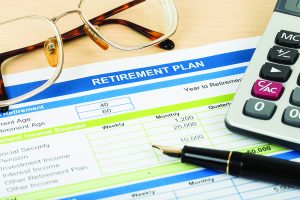Think about this analogy: When an airplane is preparing to land, it doesn’t descend 30,000 feet in a matter of seconds. Rather, it happens gradually. The pilot adjusts to the landscape and weather conditions to assure a soft landing.
In the years leading up to retirement, treat your investment portfolio in a similar manner. Prepare to protect your assets. Adjust as dictated by market and economic conditions to help assure a soft landing in retirement.
 Adjusting your portfolio means taking steps to downshift as retirement nears, reducing some of the risks that may exist in your asset mix. While you were focused on building wealth in the years leading up to retirement, your focus should change as you approach the end of your working years. It’s important to protect your hard-earned wealth, while positioning your portfolio to generate your retirement paycheck.
Adjusting your portfolio means taking steps to downshift as retirement nears, reducing some of the risks that may exist in your asset mix. While you were focused on building wealth in the years leading up to retirement, your focus should change as you approach the end of your working years. It’s important to protect your hard-earned wealth, while positioning your portfolio to generate your retirement paycheck.
Dealing with Unpredictability
Money invested in assets that vary in value — including stocks and bonds — are subject to periodic fluctuations. In prior years, you may have had time to ride out market turbulences and overcome short-term losses once markets recovered. But, if you wait until retirement to adjust your portfolio, you may be unpleasantly surprised by an untimely market downturn. This unpredictability could result in a “hard landing” for your portfolio, leaving you with less money in retirement, compared to your plans.
For example, a couple with $1 million saved for retirement may plan to withdraw $40,000 annually from that account (assuming they withdraw 4 percent of the principal value annually to sustain 25 years in retirement). If all the money was invested in stocks and the portfolio sustained a 25 percent decline prior to retirement, the value would drop to $750,000, leaving the couple with $30,000 a year. In contrast, if they had strategically positioned the portfolio prior to their retirement, they may have protected themselves from the market’s downturn.
A Gradual Process
The shift from wealth accumulation to income generation in your portfolio should happen over time. One approach is to gradually reduce your positions in assets that are subject to greater market volatility in the years leading up to retirement. That may mean reducing your portfolio’s exposure to stocks and increasing positions in fixed-income investments.
However, not all your money needs to be moved out of stocks, even in retirement. Equities historically have offered more growth potential than many other types of investments. Given today’s long-life expectancies, you want to be prepared for the likelihood that living costs will be higher 20 or 30 years from the time you begin retirement. For this reason, stocks may make sense for you. You may want to reduce your emphasis on investments that maximize capital appreciation and instead, emphasize stocks that tend to be less volatile and pay competitive dividends.
Other strategies may come into play, too, such as annuities that provide lifetime income in retirement, or alternative investments that can diversify your portfolio. A financial advisor can help you determine an appropriate strategy as you prepare for a smooth landing in retirement.
MICHAEL W. K. YEE, CFP
1585 Kapiolani Blvd., Ste. 1100, Honolulu HI 96814
808-952-1222, ext. 1240 | michael.w.yee@ampf.com
Michael W. K. Yee, CFP®, CFS®, CLTC, is a Financial Advisor, Certified Financial Planner ™ practitioner with Ameriprise Financial Services, Inc. in Honolulu, HI. He specializes in fee-based financial planning and asset management strategies and has been in practice for 30 years.
Investment advisory products and services are made available through Ameriprise Financial Services, Inc., a registered investment adviser.
Ameriprise Financial Services, Inc. Member FINRA and SIPC.
© 2017 Ameriprise Financial, Inc. All rights reserved. File #1822778


Leave a Reply